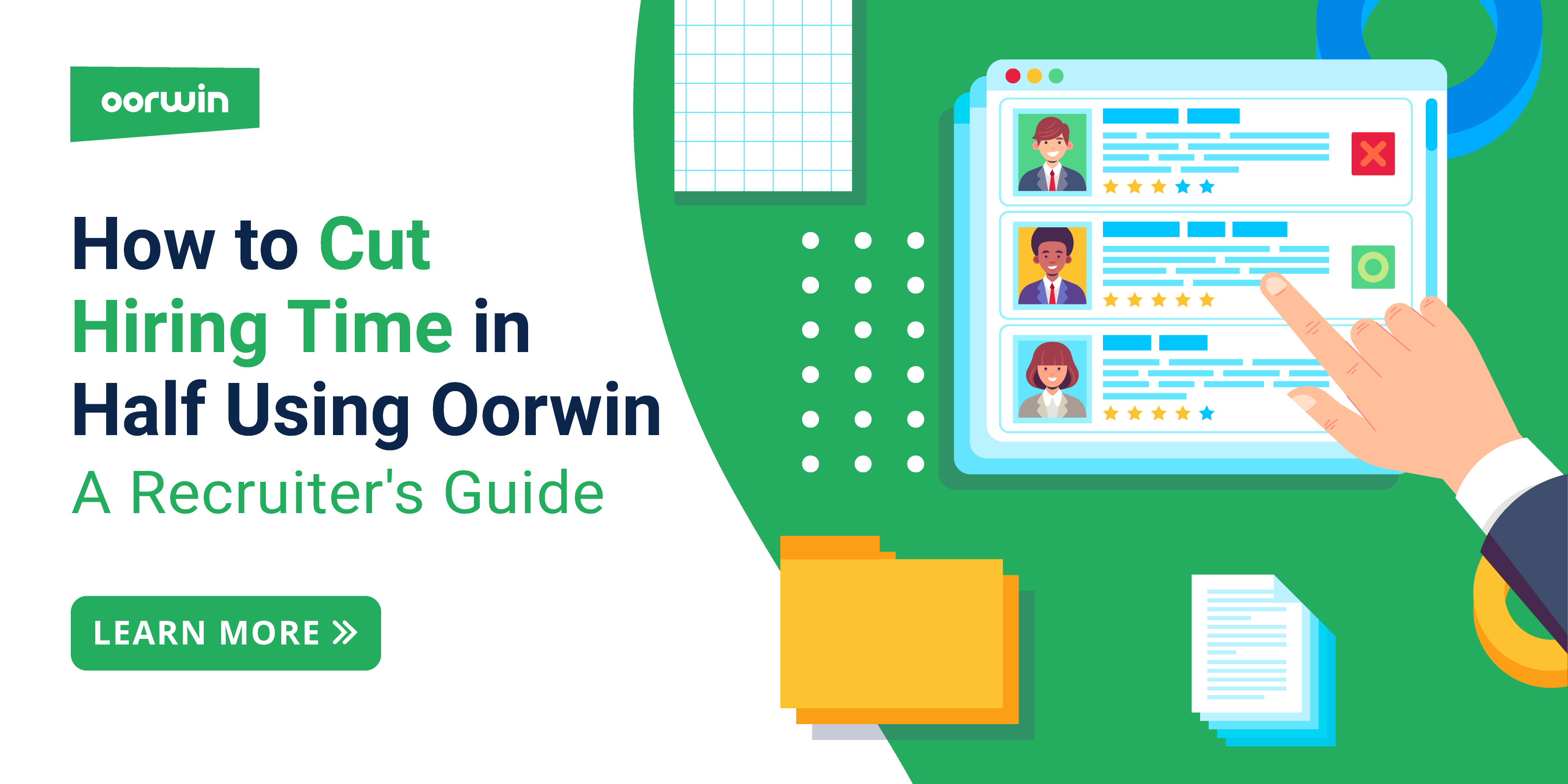How to Use Recruiting Automation for Effective Hiring in 2023
Oorwin
9min read / 30 Sep 2020

Related Articles
Recruitment automation refers to the use of technology to automate tasks in the recruitment process. This can include sourcing candidates, screening resumes and job applications, scheduling and conducting interviews, and hiring new employees. A recruitment automation system will be essential in helping organizations find, attract, and recruit top talent efficiently.
Recruitment automation can be carried out using various tools, such as applicant tracking systems (ATS), which can manage job postings, resumes, and other recruitment-related data.
Purpose of Recruiting Automation
Recruitment automation aims to make the recruitment process more efficient and effective by reducing the amount of manual work involved and allowing recruiters to focus on higher-level tasks, such as evaluating candidates and building relationships with clients. Recruiting automation can also help ensure fairness and consistency in the recruitment process by standardizing tasks and providing objective measures of candidates’ abilities.
Enhancing Recruitment Process
Recruiting top talent is crucial for propelling innovation. It is no longer enough to find suitable candidates, which might we add, has become a feat by itself. Recruiters must rely on something other than the candidate to show off their skills to win a job opportunity. Passive and social hiring strategies make attracting and engaging talent just as important.
The increasing pressure on companies to attract and hire ideal job candidates demand an enhanced hiring process and practices. Recruitment automation rises to the challenge.
Ensuring Efficiency When Recruiting at Scale
Corporate job offers attract 250 resumes on average. Of those 250, four to six get called for an interview, and only one gets the job, according to a Glassdoor report.
The sheer amount of information about candidates, from online profiles to inbound resumes, tests the ability to recruit teams to process. Most hiring teams don’t have enough time to adequately source, assess, and screen candidates.Recruiting automation systems can help companies analyze candidate data quickly to help them make better decisions, fast.
Retaining Competitive Advantage
A while ago, we would have said recruitment automation was inevitable for companies looking to increase their competitive advantage in hiring. That is no longer the case.
Today, a candidate’s hiring experience is just as necessary as the process. This calls for automating mundane and repetitive tasks so that the recruiters can focus on more quality tasks.
As more and more companies use Automation in their hiring process, several others are adopting it to stay up-to-date and relevant to retain their competitive advantage.
Eliminating Bias
Unconscious bias continues to be on top of the minds of talent acquisition leaders. Recruiters believe the most significant barrier to hiring diverse talent lies in the sourcing and qualification process.
Recruitment automation systems can address this challenge. Companies can work around unconscious bias by adding a layer between recruiters and candidates in processing applications.
Benefits of Recruitment Automation System for Staffing Firms
Ease of Gathering Data
Automation can help capture and organize data about job candidates, such as resumes, job applications, and interview notes. This can make it easier to search and filter through candidates and track recruitment efforts’ progress.
Save Time
Automation can save time by automating tasks such as scheduling interviews, sending emails and messages, and posting job openings. This can allow staffing firms to focus on more high-level tasks.
Increased Efficiency
Automation can increase efficiency by streamlining and standardizing recruitment processes. For example, an automated system can ensure that all candidates are asked the same questions during an interview, which can help with fairness and consistency in the selection process.
Ease of Recruitment
Automation can also help with recruitment efforts by posting job openings on various job boards and social media platforms and reaching out to potential candidates through email or other means. This can help staffing firms expand their pool of qualified talents.
Steps of Recruitment Automation
The steps of recruitment automation can be decided by looking at the recruiting funnel, from job specifications to talent sourcing to the final hiring decision. It supports both candidates and recruiters through the hiring process.
Here is where companies find recruitment automation software the most useful:
- Sourcing – 39.6%
- Candidate qualification – 15.8%
- Interview scheduling – 15.8%
- Engaging candidates – 11.9%
- Team collaboration – 7.9%
- Candidate nurturing – 6.9%
1. Sourcing
Automation can help with sourcing candidates by posting job openings on various job boards and social media platforms and by reaching out to potential candidates through email or other means. This can expand the pool of qualified candidates and make finding the right fit for the job easier.
2. Pre-screening
More than 50% of companies perform background checks to improve the quality of their new hires, according to SHRM. Recruiting Automation can reduce the need for background checks and make it easier to send background checks as needed.
By deploying AI solutions or automated skill tests, hiring teams can bypass the need to verify a person’s credibility independently. Skills assessments allow candidates to showcase their talent in a real challenge making the results more valuable to a hiring manager than, say, a reference check.
Some tools can scan online databases to verify a candidate’s background information while complying with employee rights and protection.
3. Screening
Up to 88% of resumes received for a role need to be qualified. A recruiter spends 23 hours on average screening resumes for a single hire. Resume screening is still one of the biggest bottlenecks in recruitment.
Recruiting Automation can help screen candidates by automatically sorting and filtering resumes and applications based on predetermined criteria, such as education, experience, and skills. This can save time and ensure that only the most qualified talents are considered for further evaluation.
4. Assessments
Various types of assessments can be automated, including aptitude tests, personality tests, skills assessments, and knowledge tests. Automated checks can be administered online, which can be convenient for recruiters and allow a larger pool of potential employees to be assessed.
Automated assessments can also ensure fairness and consistency in recruitment by providing standardized and objective measures of candidates’ abilities. This can be particularly useful when evaluating a large number of candidates or when hiring for roles that require specific skills or knowledge.
5. Scheduling
Recruitment automation system can track the progress of candidates’ applications in the hiring process. Some systems can automatically place successful applicants into open interview slots with the help of a pre-built scheduling module capable of syncing with the schedule of all line managers.
This is a great way to make the best use of time and fill up slots with candidates across a shorter period to allow a more precise and accurate comparison of their interview performance. Recruiters can also send automated reminders to keep candidates up-to-date on the next steps, like upcoming scheduled interviews and assessments due. This, in turn, makes the candidates more prepared for the forthcoming steps.
6. Nurturing
Candidate nurturing is an essential aspect of building and maintaining an employer brand. Employer branding is a company’s ability to promote and differentiate its identity to prospective employees. Everything that companies do (and don’t) adds to the candidate’s experience with the company.
It is, therefore, essential to maintain a relationship with candidates throughout the entire hiring process. Recruitment automation makes way for candidate nurturing tools that allow companies to engage candidates through email automation.
A lot of communication between recruiters and candidates can be automated to ensure that candidates stay informed about the updates and are engaged in the hiring process. Automated email flows hire the candidates throughout the hiring process, so they maintain interest in the position.
Introducing Oorwin’s automation-ready ATS
For companies that recruit frequently, applicant tracking systems (ATS) and recruiting software solutions are also beneficial. These systems with recruiting automation are likely to become increasingly popular as they allow companies to track and monitor the progress of their recruitment process quickly.
Oorwin’s intelligent ATS can automatically harvest resumes, screen candidates, test applicants, schedule interviews, manage the hiring process, check references, and complete new-hire paperwork. With Oorwin ATS, you can reduce your time to hire by 70% and the cost per hire by 60%.
Sign up for a free trial today to explore all the fantastic features Oorwin offers.
Frequently Asked Questions
What is recruitment automation?
Recruitment automation refers to using technology to automate tasks and processes in the recruitment process. This can include sourcing talents, screening resumes and job applications, scheduling and conducting interviews, and hiring new employees.
Why is recruitment automation essential?
Recruitment Automation can help staffing firms save time, reduce costs, and improve the efficiency and effectiveness of the recruitment process.
What are the benefits of recruiting automation systems?
The benefits are it improves the consistency and quality of hiring, increases the HR team’s productivity by reducing the workload, saves time, increases the open positions’ social reach, improves recruitment tactics, streamlines the gathering of data, and enables businesses to locate the best people.
Popular Articles..
Blog

7min read / 25-Jun-2025
Master Effective Interview Techniques with Oorwin: A Step-by-Step Recruiter’s Guide
Blog
Blog
Get the latest Oorwin releases, updates, success stories & industry news
 Back
Back
